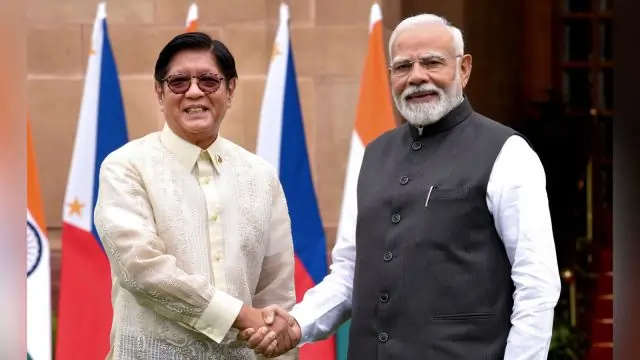New Delhi: On August 5, 2025, India and the Philippines ushered in a new era of bilateral relations by announcing the establishment of a Strategic Partnership during the state visit of Philippine President Ferdinand R. Marcos Jr. to India. This landmark development, coinciding with the 75th anniversary of diplomatic ties established in 1949, aims to deepen cooperation across political, defense, economic, cultural, and technological domains. The partnership is guided by a comprehensive Plan of Action (2025–2029), signed during the visit, marking a significant milestone in India-Philippines relations.

A Historic State Visit Strengthening Ties
Philippine President Ferdinand R. Marcos Jr., accompanied by First Lady Louise Araneta Marcos, several cabinet ministers, and a high-level business delegation, arrived in India on August 4, 2025, at the invitation of Prime Minister Narendra Modi. The visit, spanning August 4–8, was packed with ceremonial and diplomatic engagements. On August 5, President Marcos received a ceremonial reception at Rashtrapati Bhavan and paid floral tributes to Mahatma Gandhi at Raj Ghat. Bilateral talks between Prime Minister Modi and President Marcos culminated in the exchange of bilateral documents, followed by a luncheon hosted by Modi. President Marcos also called on Indian President Droupadi Murmu, who hosted a banquet in his honor. India’s External Affairs Minister, Dr. S. Jaishankar, met with Marcos, and the Philippine leader was scheduled to visit Bengaluru, a hub of India’s technology and innovation ecosystem.
The visit celebrated 75 years of diplomatic relations, rooted in the 1952 Treaty of Friendship, the 2000 Memorandum of Understanding on Policy Consultation Talks, the 2007 Agreement on the Establishment of a Joint Commission on Bilateral Cooperation, and the 2007 Declaration on the Framework of Bilateral Cooperation. These agreements have laid a strong foundation for the newly announced Strategic Partnership, which seeks to elevate bilateral ties to address 21st-century challenges.
Key Agreements and Memoranda of Understanding
The state visit resulted in the signing of 13 key agreements and memoranda of understanding (MoUs), reflecting the depth and breadth of India-Philippines cooperation. These agreements, announced by the Press Information Bureau (PIB) Delhi on August 5, 2025, include:
- Declaration on the Establishment of Strategic Partnership: Formalizing the strategic alliance between India and the Philippines.
- India-Philippines Strategic Partnership: Plan of Action (2025–2029): A roadmap to guide cooperation over the next five years.
- Terms of Reference for Air Staff Talks: Between the Indian Air Force and the Philippine Air Force.
- Terms of Reference for Army-to-Army Staff Talks: Between the Indian Army and the Philippine Army.
- Terms of Reference for Navy-to-Navy Talks: Between the Indian Navy and the Philippine Navy.
- Treaty on Mutual Legal Assistance in Criminal Matters: Enhancing cooperation in addressing cross-border crime.
- Treaty on Transfer of Sentenced Persons: Facilitating the repatriation of sentenced individuals.
- Programme of Cooperation in Science and Technology (2025–2028): Between India’s Department of Science and Technology and its Philippine counterpart.
- Implementation Program on Tourism Cooperation (2025–2028): Between India’s Ministry of Tourism and the Philippines’ Department of Tourism.
- MoU on Cooperation in Digital Technologies: Promoting collaboration in emerging technologies.
- Statement of Intent on Space Cooperation: Between the Indian Space Research Organisation (ISRO) and the Philippine Space Agency for peaceful uses of outer space.
- Terms of Reference for Enhanced Maritime Cooperation: Between the Indian Coast Guard and the Philippine Coast Guard.
- Cultural Exchange Programme: Renewed to foster people-to-people ties.
These agreements underscore the multifaceted nature of the partnership, covering defense, legal cooperation, science, technology, tourism, and cultural exchanges.
Key Announcements to Bolster Cooperation
In addition to the signed agreements, several significant announcements were made to strengthen ties:
- Support for Philippines’ Sovereign Data Cloud Infrastructure: India committed to supporting a pilot project to establish a sovereign data cloud infrastructure in the Philippines, enhancing digital capabilities.
- Invitation to Join the Information Fusion Centre–Indian Ocean Region (IFC-IOR): The Philippines was invited to participate in this India-led initiative to enhance maritime domain awareness.
- Gratis E-Tourist Visa for Filipino Nationals: Starting August 2025, Filipino nationals will benefit from a one-year visa-free entry to India, boosting tourism.
- Commemorative Stamp for 75th Anniversary: A joint issuance of a commemorative stamp to mark 75 years of diplomatic relations.
- Negotiations for a Preferential Trade Agreement (PTA): Adoption of terms of reference to expedite PTA negotiations, aiming to boost bilateral trade.
Dimensions of India-Philippines Relations
The Strategic Partnership builds on decades of collaboration, strengthened by India’s Look East Policy (1992) and Act East Policy (2014). The key dimensions of this relationship include:
Defense and Security Cooperation
The Philippines is a significant partner in India’s defense strategy, notably as the first foreign buyer of the BrahMos missile, a supersonic cruise missile developed jointly by India and Russia. The first Track-1 Maritime Dialogue, held in Manila from December 11–13, 2024, marked a milestone in maritime cooperation. The partnership emphasizes:
- Institutional Mechanisms: Regular convening of the Joint Defence Cooperation Committee (JDCC) and Joint Defence Industry and Logistics Committee (JDILC) to foster defense industrial collaboration, technology transfer, and capacity building.
- Military Engagements: Institutionalizing military training, tri-service cooperation, and participation in multilateral exercises like the ASEAN-India Maritime Exercise and Exercise MILAN.
- Maritime Security: Collaboration in shipbuilding, coastal surveillance, humanitarian assistance, disaster relief (HADR), pollution control, and search and rescue (SAR) operations.
- Counter-Terrorism and Cyber Security: Strengthening efforts to combat terrorism, cyber-crimes, and emerging threats through the Joint Working Group on Counter-Terrorism and cooperation in digital forensics and Computer Emergency Response Team (CERT) activities.
Economic Engagement
Bilateral trade between India and the Philippines reached $3.5 billion in 2023–24, supported by the ASEAN–India Free Trade Agreement. The ongoing negotiations for a Preferential Trade Agreement aim to further boost trade. Key initiatives include:
- Trade and Investment: Promoting business linkages, resolving market access issues, and fostering collaboration in renewable energy, critical minerals, electric vehicles, digital technologies, biotechnology, and infrastructure.
- Customs Cooperation: Facilitating trade through simplified customs procedures via the Joint Customs Cooperation Committee.
- Healthcare and Pharmaceuticals: Enhancing cooperation to improve health outcomes through joint research and capacity building.
Science, Technology, and Innovation
The partnership emphasizes joint research and development in science and technology, with a focus on:
- Space Cooperation: Collaboration between ISRO and the Philippine Space Agency for peaceful uses of outer space.
- Nuclear Energy and Agriculture: Joint initiatives in nuclear energy applications and sustainable agriculture, including rice production and aquaculture.
- Digital Technologies: Sharing best practices in education technology (Edu-tech) and medical technology (Med-tech).
People-to-People Ties
With over 70,000 Indian diaspora members in the Philippines, cultural and people-to-people ties are a cornerstone of the partnership. The renewed Cultural Exchange Programme (2019–2023, extended) promotes:
- Cultural Exchanges: Participation in scholarship programs offered by the Indian Council of Cultural Relations (ICCR).
- Tourism: Encouraging exchanges between tourism professionals and the hospitality sector, supported by the Joint Working Group on Tourism.
- Capacity Building: The Philippines benefits significantly from India’s Indian Technical and Economic Cooperation (ITEC) program, fostering training and skill development.
Strategic Significance in the Indo-Pacific
The India-Philippines Strategic Partnership aligns with a shared vision for a free, open, and rules-based Indo-Pacific region, with ASEAN Centrality at its core. Both nations reaffirmed their commitment to the 1982 UN Convention on the Law of the Sea (UNCLOS) and the 2016 Arbitral Award on the South China Sea, which upheld the Philippines’ Exclusive Economic Zone (EEZ) and rejected China’s “historic rights” claims. This partnership positions India as a credible balancing partner for the Philippines amid China’s assertiveness in the region.
The partnership also supports India’s MAHASAGAR Vision, which emphasizes maritime security and cooperation in the Indian Ocean and Pacific regions. Collaborative efforts in maritime domain awareness, hydrography, and oceanographic research aim to ensure safe and sustainable use of marine resources.
Multilateral and Global Cooperation
India and the Philippines are committed to reshaping global governance to address challenges like climate change, technology, and inequality. Key areas of cooperation include:
- United Nations Reforms: Supporting the expansion of the UN Security Council in both permanent and non-permanent categories through text-based negotiations.
- Climate Change Initiatives: Collaboration in the International Solar Alliance, Coalition for Disaster Resilient Infrastructure, Global Biofuels Alliance, and Mission Lifestyle for Environment (LiFE).
- ASEAN-India Partnership: Deepening engagement through ASEAN-led mechanisms and the ASEAN-India Joint Statement on Cooperation on the ASEAN Outlook on the Indo-Pacific (AOIP).
- Global South Advocacy: The Philippines’ active participation in the Voice of the Global South Summit (VOGSS) reflects shared priorities in representing developing nations.
A Partnership for the Future
Prime Minister Modi aptly described the relationship, stating, “India and the Philippines are friends by choice and partners by destiny. From the Indian Ocean to the Pacific, they are united by shared values.” The Strategic Partnership is a testament to the mutual commitment to peace, stability, and prosperity in the Indo-Pacific region. By leveraging historical ties, shared values, and complementary strengths, India and the Philippines are poised to unlock new opportunities for collaboration in the coming years.
The Plan of Action (2025–2029) provides a clear roadmap for achieving these goals, with regular high-level exchanges, institutional mechanisms, and joint initiatives ensuring sustained momentum. As both nations navigate a complex global landscape, this partnership will serve as a beacon of cooperation, fostering progress and resilience for their people and the broader region.
Frequently Asked Questions (FAQs)
1. What is the India-Philippines Strategic Partnership?
The India-Philippines Strategic Partnership is a formal agreement announced on August 5, 2025, during the state visit of Philippine President Ferdinand R. Marcos Jr. to India. It aims to deepen bilateral cooperation across political, defense, economic, cultural, and technological domains, guided by a Plan of Action (2025–2029). The partnership marks 75 years of diplomatic relations and builds on shared values, mutual respect, and a commitment to a free, open, and rules-based Indo-Pacific region.
2. What agreements were signed during the state visit?
During the visit, 13 agreements and MoUs were signed, including the Declaration on the Establishment of Strategic Partnership, the Plan of Action (2025–2029), terms of reference for military talks (Air Force, Army, Navy, and Coast Guard), treaties on mutual legal assistance and transfer of sentenced persons, cooperation in science and technology (2025–2028), tourism (2025–2028), digital technologies, space, and a renewed Cultural Exchange Programme.
3. What are the key areas of cooperation in the partnership?
The partnership focuses on defense and security (e.g., BrahMos missile collaboration, maritime security), economic engagement (bilateral trade, Preferential Trade Agreement), science and technology (space, nuclear energy, agriculture), people-to-people ties (cultural exchanges, ITEC program), and multilateral cooperation (UN reforms, climate change initiatives). It also emphasizes maritime cooperation, counter-terrorism, and digital technology advancements.
4. How does the partnership address regional challenges like the South China Sea?
Both nations reaffirm their commitment to international law, including the 1982 UN Convention on the Law of the Sea (UNCLOS) and the 2016 Arbitral Award, which upheld the Philippines’ Exclusive Economic Zone rights in the South China Sea. The partnership positions India as a credible balancing partner for the Philippines against China’s assertiveness, promoting a free, open, and rules-based Indo-Pacific region.
5. What are the key announcements made during the visit?
Key announcements include India’s support for a pilot project for the Philippines’ Sovereign Data Cloud Infrastructure, an invitation to join the Information Fusion Centre–Indian Ocean Region (IFC-IOR), a gratis e-tourist visa for Filipino nationals for one year starting August 2025, a joint commemorative stamp for the 75th anniversary of diplomatic relations, and terms of reference for negotiating a Preferential Trade Agreement.

